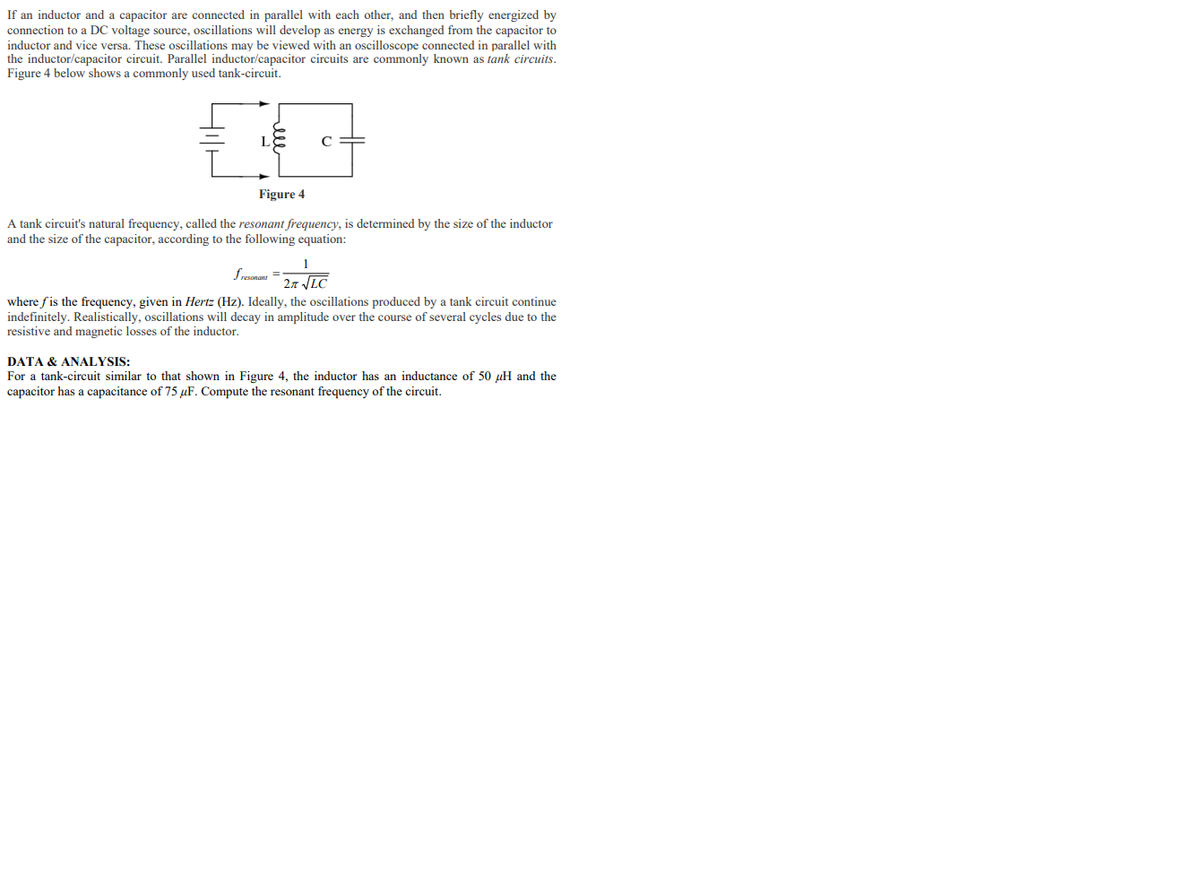If an inductor and a capacitor are connected in parallel with each other, and then briefly energized by connection to a DC voltage source, oscillations will develop as energy is exchanged from the capacitor to inductor and vice versa. These oscillations may be viewed with an oscilloscope connected in parallel with the inductor/capacitor circuit. Parallel inductor/capacitor circuits are commonly known as tank circuits. Figure 4 below shows a commonly used tank-circuit. Figure 4 A tank circuit's natural frequency, called the resonant frequency, is determined by the size of the inductor and the size of the capacitor, according to the following equation: 1 fresonant 2n √LC where fis the frequency, given in Hertz (Hz). Ideally, the oscillations produced by a tank circuit continue indefinitely. Realistically, oscillations will decay in amplitude over the course of several cycles due to the resistive and magnetic losses of the inductor. DATA & ANALYSIS: For a tank-circuit similar to that shown in Figure 4, the inductor has an inductance of 50 H and the capacitor has a capacitance of 75 µF. Compute the resonant frequency of the circuit.
If an inductor and a capacitor are connected in parallel with each other, and then briefly energized by connection to a DC voltage source, oscillations will develop as energy is exchanged from the capacitor to inductor and vice versa. These oscillations may be viewed with an oscilloscope connected in parallel with the inductor/capacitor circuit. Parallel inductor/capacitor circuits are commonly known as tank circuits. Figure 4 below shows a commonly used tank-circuit. Figure 4 A tank circuit's natural frequency, called the resonant frequency, is determined by the size of the inductor and the size of the capacitor, according to the following equation: 1 fresonant 2n √LC where fis the frequency, given in Hertz (Hz). Ideally, the oscillations produced by a tank circuit continue indefinitely. Realistically, oscillations will decay in amplitude over the course of several cycles due to the resistive and magnetic losses of the inductor. DATA & ANALYSIS: For a tank-circuit similar to that shown in Figure 4, the inductor has an inductance of 50 H and the capacitor has a capacitance of 75 µF. Compute the resonant frequency of the circuit.
Principles of Physics: A Calculus-Based Text
5th Edition
ISBN:9781133104261
Author:Raymond A. Serway, John W. Jewett
Publisher:Raymond A. Serway, John W. Jewett
Chapter23: Faraday’s Law And Inductance
Section: Chapter Questions
Problem 2CQ
Related questions
Question

Transcribed Image Text:If an inductor and a capacitor are connected in parallel with each other, and then briefly energized by
connection to a DC voltage source, oscillations will develop as energy is exchanged from the capacitor to
inductor and vice versa. These oscillations may be viewed with an oscilloscope connected in parallel with
the inductor/capacitor circuit. Parallel inductor/capacitor circuits are commonly known as tank circuits.
Figure 4 below shows a commonly used tank-circuit.
I
с
Figure 4
A tank circuit's natural frequency, called the resonant frequency, is determined by the size of the inductor
and the size of the capacitor, according to the following equation:
1
2n √LC
where fis the frequency, given in Hertz (Hz). Ideally, the oscillations produced by a tank circuit continue
indefinitely. Realistically, oscillations will decay in amplitude over the course of several cycles due to the
resistive and magnetic losses of the inductor.
fresonant =
DATA & ANALYSIS:
For a tank-circuit similar to that shown in Figure 4, the inductor has an inductance of 50 μH and the
capacitor has a capacitance of 75 μF. Compute the resonant frequency of the circuit.
Expert Solution
This question has been solved!
Explore an expertly crafted, step-by-step solution for a thorough understanding of key concepts.
Step by step
Solved in 2 steps

Knowledge Booster
Learn more about
Need a deep-dive on the concept behind this application? Look no further. Learn more about this topic, physics and related others by exploring similar questions and additional content below.Recommended textbooks for you

Principles of Physics: A Calculus-Based Text
Physics
ISBN:
9781133104261
Author:
Raymond A. Serway, John W. Jewett
Publisher:
Cengage Learning


Physics for Scientists and Engineers: Foundations…
Physics
ISBN:
9781133939146
Author:
Katz, Debora M.
Publisher:
Cengage Learning

Principles of Physics: A Calculus-Based Text
Physics
ISBN:
9781133104261
Author:
Raymond A. Serway, John W. Jewett
Publisher:
Cengage Learning


Physics for Scientists and Engineers: Foundations…
Physics
ISBN:
9781133939146
Author:
Katz, Debora M.
Publisher:
Cengage Learning

College Physics
Physics
ISBN:
9781938168000
Author:
Paul Peter Urone, Roger Hinrichs
Publisher:
OpenStax College

Physics for Scientists and Engineers, Technology …
Physics
ISBN:
9781305116399
Author:
Raymond A. Serway, John W. Jewett
Publisher:
Cengage Learning